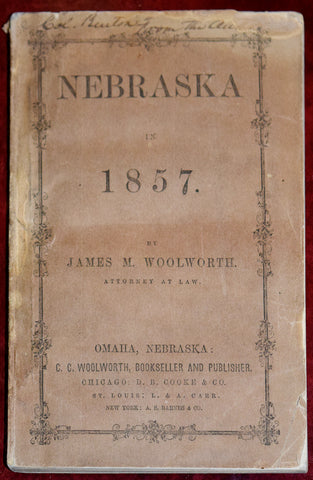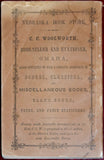James M. Woolworth, Nebraska in 1857. Omaha City, N.T.: C.C. Woolworth
James M. Woolworth
Nebraska in 1857. Omaha City, N.T.: C.C. Woolworth
New York: A.S. Barnes & Co., 1857.
8vo., (6 5/8 x 4 4/8 inches). 23-page publisher's catalogue at end. Fine folding engraved map of "Nebraska and Kanzas" prepared by J.H. Colton & Co., (12 4/8 x 14 4/8 to the outer border), on bank note paper, with original hand-colour in part and in outline (short marginal tear near mount, creased). Original brown printed paper wrappers (unevenly faded, edges creased, frayed and stained).
Provenance: inscribed by the author to "Col. Burton, from the Author" at the head of the front cover (partially obscured).
First edition. Wagner-Camp "indicates that this book was printed and published in Omaha, but it was stereotyped, printed and copyrighted in New York. It is a gazetteer of Nebraska Territory and is one of the first, if not the first, published accounts of the territory in book form. The map is from the same plate as the Colton map, Nebraska and Kansas, copyrighted 1855, in the Colton atlas, but with an inset Map of the Surveyed Portion of Nebraska, which is not present on the atlas map" (Streeter 2005).
Settlement of Nebraska did not begin in earnest until after 1848 and the California Gold Rush, which "brought a rising tide of foreign immigrants and internal migrants to the trans-Mississippi West, generating interest in promoting orderly settlement of the Great Plains... in January 1854, Senator Douglas's Committee on Territories reported a "Nebraska Bill" that, with subsequent amendments, became the Kansas-Nebraska Act. Bowing to pressure from his party's powerful southern wing, but fully expecting that climate would exclude slavery from the Great Plains, Douglas agreed that the act should explicitly repeal the Missouri Compromise line and provide for the organization of two territories, Kansas and Nebraska... Douglas hoped that the Kansas-Nebraska Act would settle the slavery issue in the territories, coalesce national Democratic support for "popular sovereignty," and further his presidential aspirations. In reality, the law triggered a violent struggle in Kansas between pro- and antislavery forces; deepened antislavery sentiment in the North; and set the stage for a new Republican party opposed to the expansion of slavery, whose 1860 presidential nominee, Abraham Lincoln, frustrated Douglas's bid for the White House" (ANB.org). Sabin 6018.




